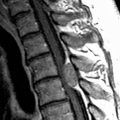 within the lower thoracic vertebral body, adjacent to the pedicle. There is characteristic nonaggressive appearance with sclerotic density and brush-like margins that suggest bone island.
within the lower thoracic vertebral body, adjacent to the pedicle. There is characteristic nonaggressive appearance with sclerotic density and brush-like margins that suggest bone island.
 with characteristic dense sclerosis and irregular, brush-like margins of the vertebral body bone island.
with characteristic dense sclerosis and irregular, brush-like margins of the vertebral body bone island.
 , without reactive marrow change or osseous destructive changes to imply an aggressive lesion.
, without reactive marrow change or osseous destructive changes to imply an aggressive lesion.
 , without reactive marrow change or other worrisome marrow abnormality. Lack of destructive change and soft tissue mass favor bone island.
, without reactive marrow change or other worrisome marrow abnormality. Lack of destructive change and soft tissue mass favor bone island.IMAGING
General Features

Full access? Get Clinical Tree
















